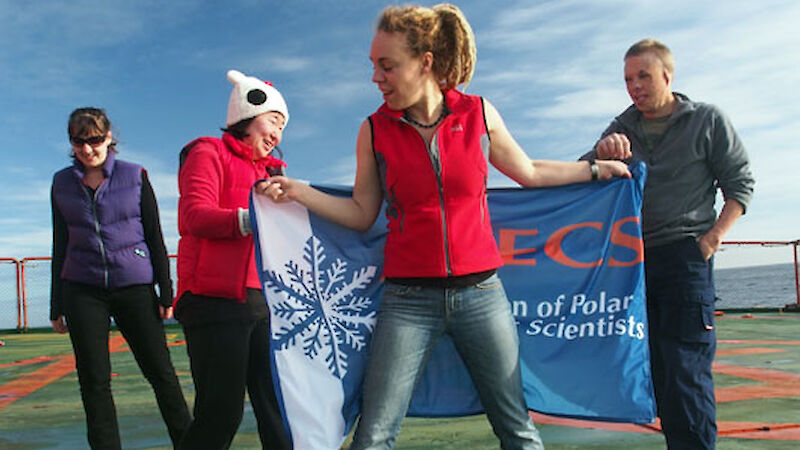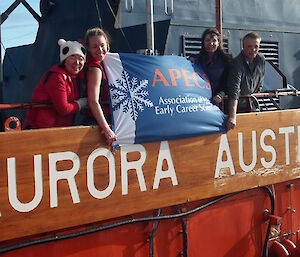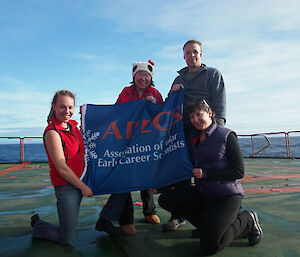Tuesday 25 September 2012
So, it’s time to meet a few more people on the ship. Among the young and enthusiastic PhD students and early career scientists on board are four who have formed a Hobart-based group of the international Association of Polar Early Career Scientists (APECS). APECS formed in 2007 to stimulate interdisciplinary and international research collaborations, and develop future leaders in polar research, education and outreach. Being a member offers networking, mentoring and career development opportunities for young scientists working in both Arctic and Antarctic research. Four of the Hobart members are on this voyage – post-doc Dr Jess Melbourne-Thomas and PhD students Molly Jia, Rob Johnson and Sarah Ugalde. Read the blog about their experiences on this voyage.
Jess
Dr Jess Melbourne-Thomas is an ecosystem modeller contributing to the development of a large, regional-scale ecosystem model for East Antarctica, spanning about one third of the area of the Southern Ocean. This model will help inform the design of monitoring strategies in the Southern Ocean – for example, where we need to collect information that will fill gaps in our knowledge, or how frequently we need to measure ecosystem components, such as krill biomass, phytoplankton productivity, or sea ice distribution.
The model will integrate information from other well developed models for physical ocean characteristics (such as currents) and the marine food web. To provide an accurate representation of the Southern Ocean ecosystem the model also needs to include the processes of sea ice formation and break-up, and sea ice thickness. However, sea ice models are less well developed than other models and Jess will use data collected from this SIPEX voyage to develop statistical representations that better capture sea ice processes.
During the voyage Jess will also contribute to bio-optical work, using a ‘radiometer’ to determine how biological material within the sea ice (such as phytoplankton) affects the wavelengths of light that can be detected underneath the ice. At the same time Jess takes her measurements, voyage Chief Scientist, Klaus Meiners, will be taking the same measurements using a radiometer on a Remotely Operated Vehicle under the ice floe. This data together will enable the team to characterise the amount and distribution of algae in sea ice – the more algae there is, the less light of certain wavelengths will penetrate the ice floe.
Sarah
Sarah is investigating primary production (photosynthesis) by Antarctic sea ice algae, and the allocation of the carbon (produced by photosynthesis) within algal cells.
When algae photosynthesise they convert energy from the sun into carbon, which they can then use for growth or the construction of internal cellular components. However, sea ice algae turn much of their carbon into extracellular mucilage (or mucus), which includes ‘extracellular polymeric substances’ (EPS). EPS are complex molecules comprised mostly of polysaccharides (sugars).
Sarah’s experiments have shown that cultured Antarctic sea ice algae excrete up to 60% of carbon produced during photosynthesis as extracellular mucilage and EPS. Studies in the Arctic have shown that there are large amounts of EPS in the sea ice, but there have been no measurements of the rates of EPS excretion in Antarctica. Sarah also wants to know what the role of EPS is … after all, why would you expend energy producing something that you then excrete?
To quantify photosynthesis and follow carbon allocation in and outside the cell, Sarah will add a radioactive tracer (14C) to algae collected from the Antarctic sea ice. When the algae photosynthesise they will incorporate the 14C into different pools of carbon, and Sarah will be able to trace where it goes using a ‘scintillation counter’. She’ll also be able to see how much of the carbon is used to produce EPS, and then change the environmental conditions in which the cells grow to see what effect this has on EPS production.
One theory is that EPS might help create a more favourable micro-environment around algae cells growing in sea ice. When the algae are first incorporated into the sea ice from the ocean, along with bacteria, viruses and other organic matter, they exist in an environment that’s conducive to growth – with suitable concentrations of carbon dioxide and nutrients. As the cells photosynthesise the environment changes, often to lower and less favourable concentrations of carbon dioxide and nutrients. As EPS production increases rapidly with algal stress, Sarah wonders how much EPS Antarctic sea ice algae produce and if the molecules are important in helping manage changes in this unfavourable environment.
EPS might also be important because bacteria are thought to use them as an energy resource, and then excrete nutrients which algae can then utilise. So is there a symbiotic relationship between algae and bacteria, with algae using EPS to effectively ‘farm’ bacteria? It is a fascinating question; one that Sarah hopes to gain further insights into on this trip.
Next time we will meet Rob Johnson and Molly Jia.



